 |
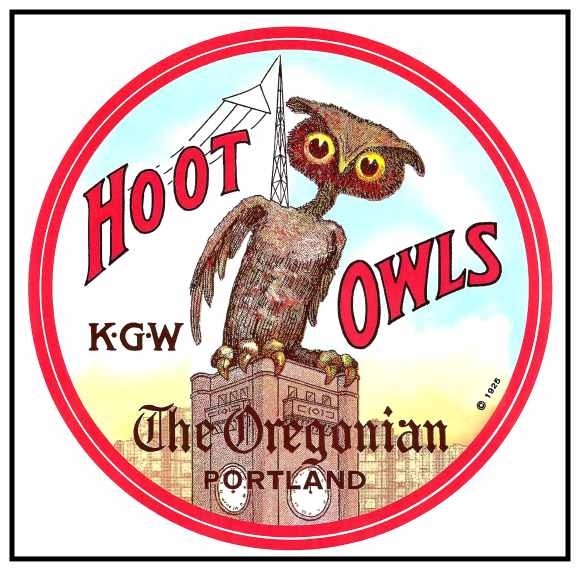 |
|||||||||||||||||||
|
|
||||||||||||||||||||
 |
||||||||||||||||||||
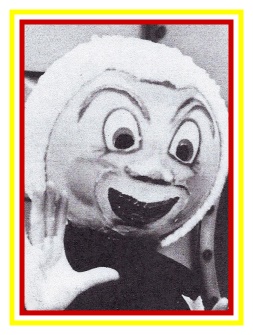 |
 |
||
 |
|||
|
|
|||||||||||||||||||||
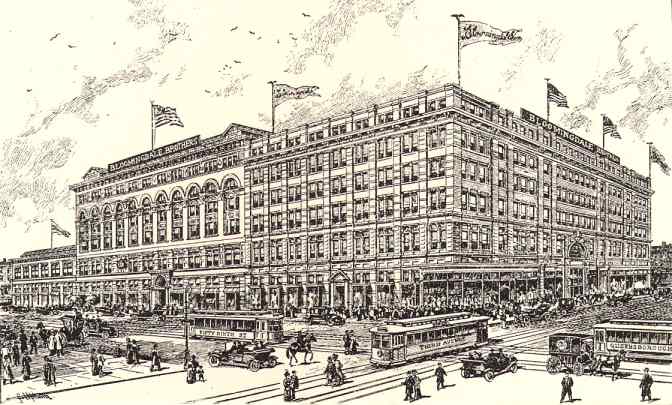 |
|
Early view of Bloomingdale’s at Third Avenue and 59th Street in New York City. |
|
Bloomingdale’s Department Store opened in 1872 with humble beginnings on Third Avenue in the growing town of Manhattan and it has become the icon of elegance in America. |
|
In the years following the Civil War, New York, the Empire City, began to emerge as a sophisticated metropolis. One of the leaders in this renaissance was Lyman Bloomingdale, founder of the Great East Side Bazaar. He was blessed with three great attributes: energy, daring and imagination. These three adjectives could be used to describe New York and Bloomingdale’s, which have become the center of style for the world. Lyman Bloomingdale helped to shape New York and New York helped to shape Bloomingdale’s. |
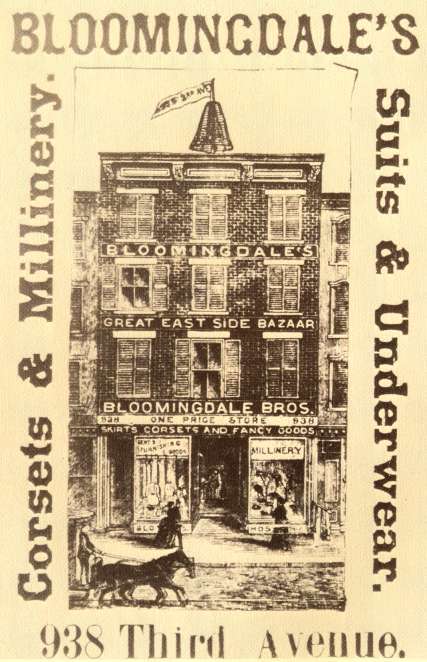 |
|||
|
The original Bloomindale’s store in 1872. |
|||
|
Having begun working part-time in the retail trade at age 11, Lyman Bloomingdale decided to go out on his own at the age of 31. He teamed up with his brother Joseph to start their own business. By choosing a storefront with two large plate glass windows, the Bloomingdale Brothers opened a 20’ by 75’ store at 938 Third Avenue on a cool, sunny day in April of 1872. Sales at the end of the day totaled $3.68, but they weren’t discouraged. Within a month of opening their store, business had become brisk enough to convert the stockroom into an expanded sales floor. Lyman recognized the value of using the metropolitan dailies to advertise their wares. As the nation entered a depression in September 1873, eighteen months after opening, the Bloomindale Brothers recognized the need to redirect their merchandising policy to “offer the best possible value for the least possible price”. Three years after the depression began, it finally burned itself out and Bloomingdale Brothers acquired a five-story building with good window space on the corner of 56th Street and Third Avenue. Suddenly, Bloomindale’s had become a department store. By 1879, the new Third Avenue “El” (elevated) Train raced along the East Side from 67th to 129th Streets and with it came the masses from the suburbs. A combination of Lyman’s inventiveness and creativity as well as the proximity to the “El” Train increased sales to over $851,000 by 1883. When electric lights and telephones were invented, Lyman used them bring the crowds and increase sales . Expansion came again in 1886, just as New York’s most well-known landmark, the Statue of Liberty, was unveiled. Lyman was preoccupied with the move to their new store at 59th Street and Third Avenue. Destiny had decided that this would be Bloomingdale’s last move. Joseph decided to retire and Lyman continued to thrill his customers. When Lyman installed elevators in his new six-story building, he called them “sky carriages”. The wondrous conveyances were finished in plate glass mirrors and fine mahogany. Each of the “sky carriages” had small upholstered seats to carry the customers from floor to floor. |
|
|
Painted mural on the West Wall of Bloomingdale Bros. |
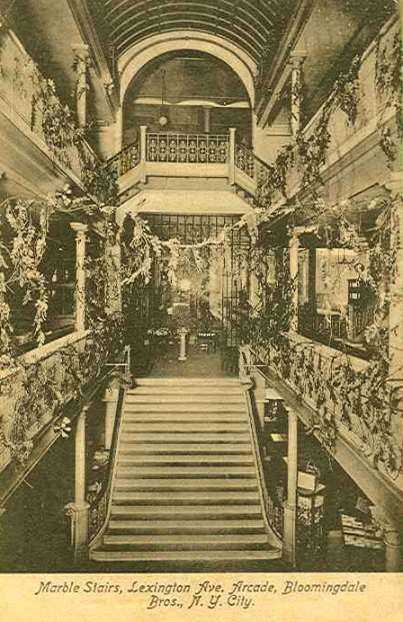 |
||
|
First Floor inside Bloomindale Bros. |
||
|
As European furnishings and antiques became popular, Bloomingdale’s established a buying office in Paris which was soon followed by offices in other metropolises including Vienna and Berlin. As sales rose, Bloomingdale’s outgrew the new store and Lyman began to acquire the remaining portions of the block. Within 15 years, he had acquired 80 percent of what is now Bloomingdale’s flagship store. |
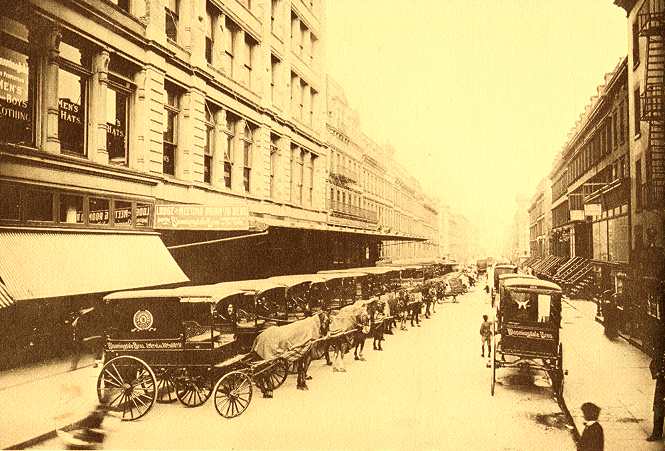 |
||
|
Delivery wagons line the loading dock for loading before making their deliveries. |
||
|
Helping with real estate negotiations was Lyman’s oldest son, Samuel, who nearly matched his father for energy, creativity and devotion to the success of Bloomingdale’s. Lyman Bloomingdale was very generous in many philanthropic gestures. He contributed to many causes and during the Spanish-American War, Lyman gave over most of the space in the men’s furnishings department to the Federal Government. He erected a recruitment center and granted leaves of absence with full pay to all of his employees who volunteered for the war effort. When Lyman passed away in 1905, management of the store passed to his heirs, Samuel, Hiram and Irving. Bloomingdale’s continued to prosper as business exceeded five million dollars. One of Lyman’s pet projects finally came to fruition when the 59th Street Bridge was completed in 1909. |
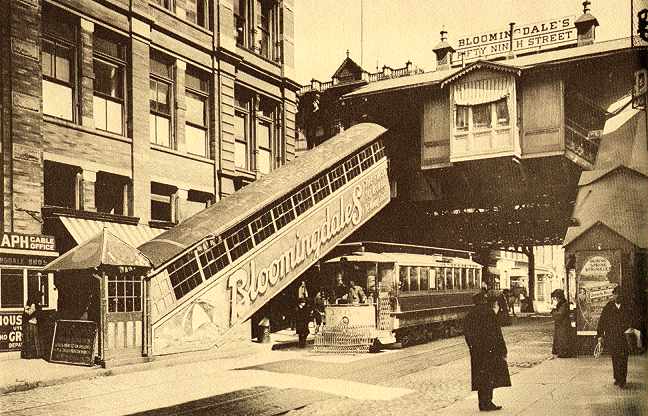 |
||
|
View of a streetcar at the “El” Train station and stairway at 59th Street. |
||
|
As New York’s transportation system grew, the catchy slogan commissioned by Samuel Bloomingdale in 1902, “All cars transfer to Bloomingdale’s” became a reality. The slogan was everywhere, on billboards, delivery wagons and beach umbrellas. |
|
|
Richard Outcalt, the creator of Buster Brown comic strips, immortalized the slogan with this post card of Santas transferring to Bloomingdale’s. |
|
As the neighborhoods became revitalized, new houses rose around Bloomingdale’s, creating the need for lots of furnishings. The grocery, delicatessen, fresh meat, wine and spirits departments were daily stops for the maids and matrons who worked and lived in these new houses. The Greenhouse became popular for those who wanted the air of a country estate in the middle of Manhattan. |
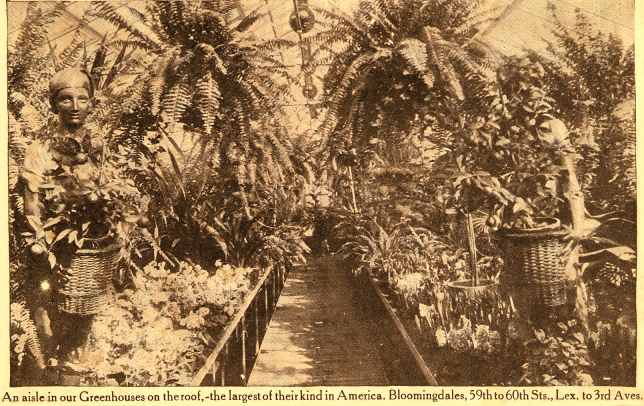 |
|
|
View of Bloomingdale’s Greenhouses on the roof. |
|
Expansion became inevitable and in 1917, Bloomingdale’s now occupied nearly the entire block from Lexington to Third Avenue and from 59th to 60th Streets. Soon afterward Bloomingdale’s was incorporated and Samuel Bloomingdale became the first president. In 1927, with the purchase of the three remaining small residential parcels in the block, work began on a new Lexington Avenue entrance. By the end of the decade, sales had exceeded 24 million dollars. Just as the nation headed into the Great Depression, Bloomingdale’s joined the Federated Department Stores, Inc. By joining forces with Federated, Bloomingdale’s survived the depression and World War II. After the war, retailing became theater with “lights, camera, action”. In the 1950’s Bloomingdale’s began to build stores outside of Manhattan. When the “El” Train came down, Bloomingdale’s remodeled the Third Avenue entrance in 1955. New escalators were installed in 1972. Bloomingdale’s continues to be on the cutting edge of style and fashion. Designers Ralph Lauren, Perry Ellis, Norma Kamali and many others got their first truly big opportunities at Bloomingdale’s. Currently, Bloomingdale’s has 40 stores from coast to coast. |
|
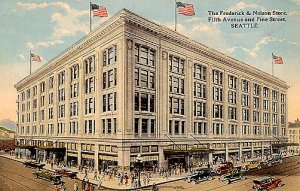 |
||||||
|
Last updated 10-23-16 |
||||||
|
copyright © 2017 PdxHistory.com |
| [Portland History] [Site Map] [Amusement Parks] [Historic Portland] [Department Stores] [Bloomingdales] [Streetcars] [Railroads] [Mt Hood] [Oregon Coast] [Post Card History] [Portland Hotels] [Portland Neighborhoods] [Getaways] [Contact Us] |
